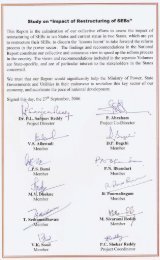CDM based CFL scheme - Ministry of Power
CDM based CFL scheme - Ministry of Power
CDM based CFL scheme - Ministry of Power
Create successful ePaper yourself
Turn your PDF publications into a flip-book with our unique Google optimized e-Paper software.
<strong>CFL</strong>s. Hence, a mandatory regulation for compulsory<br />
use <strong>of</strong> <strong>CFL</strong> in place <strong>of</strong> ICL is not foreseen.<br />
The second alternative-- autonomous growth <strong>of</strong> <strong>CFL</strong>s<br />
in domestic lighting in India, though a possibility faces<br />
a number <strong>of</strong> barriers and would not occur anyway in<br />
India. The barriers are listed as under:<br />
Barrier at Consumer Level<br />
1. High initial capital cost <strong>of</strong> <strong>CFL</strong> and high consumer<br />
discount rate - The electricity consumer in<br />
households even if they understand that they will<br />
save money from energy efficiency (EE)<br />
investments, will only invest in EE measures if<br />
the financial returns occur for sure and that too<br />
in the very short term.<br />
Domestic consumers <strong>of</strong>ten have a limited<br />
understanding <strong>of</strong> the benefits <strong>of</strong> EE investments.<br />
They are <strong>of</strong>ten cash-constrained and since the<br />
investment in <strong>CFL</strong> is nearly 10 times that <strong>of</strong> ICL,<br />
domestic consumers are not willing to make such<br />
investments.<br />
2. Lack <strong>of</strong> information - in a developing country like<br />
India, there is insufficient information about the<br />
costs and benefits <strong>of</strong> energy efficiency,<br />
particularly, with the domestic consumer. The<br />
efforts <strong>of</strong> the Bureau <strong>of</strong> Energy Efficiency (BEE)<br />
under the BLY <strong>scheme</strong> are focused towards<br />
enhancing consumer awareness and promote<br />
energy efficiency.<br />
3. Split incentives - Especially in the case <strong>of</strong> new<br />
buildings , the builder or owner <strong>of</strong> a home or<br />
building does not pay the energy bills, he/she<br />
usually have little financial incentive to make EE<br />
improvements, while the resident owner / tenants,<br />
who pays the bills, does not want to make major<br />
EE investments in property they do not own.<br />
4. Doubts that promised savings will accrue - Some<br />
<strong>of</strong> the earlier versions <strong>of</strong> <strong>CFL</strong>'s launched in the<br />
Indian market were <strong>of</strong> low quality and had large<br />
failure rates. Since the Indian Standard for <strong>CFL</strong>s<br />
has been implemented, a minimum level <strong>of</strong><br />
20 Bureau <strong>of</strong> Energy Efficiency<br />
quality is assured. However, consumers are still<br />
skeptical about the energy savings that will accrue<br />
from their <strong>CFL</strong> use.<br />
5. Incentives not high enough - Domestic energy<br />
users do not have a financial incentive to<br />
implement EE measures. They operate the <strong>CFL</strong><br />
for a very short duration 11 coupled with the lower<br />
tariff structure 12 in comparison with commercial<br />
users and hence the incentive for them to adopt<br />
<strong>CFL</strong> is low.<br />
Technology Barrier<br />
— <strong>Power</strong> Factor: BIS plan to implement a<br />
mandatory standard which require <strong>Power</strong> Factor<br />
(PF) <strong>of</strong> 0.85 and above for <strong>CFL</strong> bulbs (at present<br />
the PF is ? 0.5). These High PF Bulbs, given the<br />
technology built-in, are likely to be priced 20%<br />
higher. With this included the economics change<br />
considerably<br />
— Poor Quality <strong>of</strong> <strong>Power</strong> Supply: <strong>CFL</strong>s unlike an<br />
ICL are more susceptible to failure. This is because<br />
<strong>CFL</strong>s include electronic parts whereas ICLs just<br />
make use <strong>of</strong> a resistive load. Moreover, ICLs can<br />
work at very low voltages and emit light. <strong>CFL</strong>s<br />
on the other hand can emit light only with a<br />
voltage greater than 170 V. To address the quality<br />
issues, starting 2006, an Indian standard 15111<br />
has been applied to all <strong>CFL</strong>s sold in the Indian<br />
market.<br />
Barrier at Market Level<br />
1. Unavailability <strong>of</strong> energy-efficient products -<br />
Manufacturers <strong>of</strong>ten do not make or market more<br />
energy-efficient products, especially in non-urban<br />
centers, as they do not expect to have a market<br />
for these products. In addition, product<br />
distributors and retailers <strong>of</strong>ten do not have any<br />
incentive to stock or aggressively display energyefficient<br />
products, making it difficult for willing<br />
customers to find the efficient products they may<br />
seek.<br />
2. Insufficient domestic manufacturing capability-<br />
Manufacturers in India are not developing in-<br />
11 Unlike a commercial user where expected hours <strong>of</strong> usage can be more than 4 hours a day, a residential user averages just 3-4 hours a day. The<br />
hours <strong>of</strong> usage also widely vary depending on the power supply in each state and the socio-economics <strong>of</strong> the household.<br />
12 Refer Section E.4, the domestic electricity tariff is very low (Rs 1.2 to 5.6) as compared to a much higher commercial sector tariff (Rs 4 to 11).

















